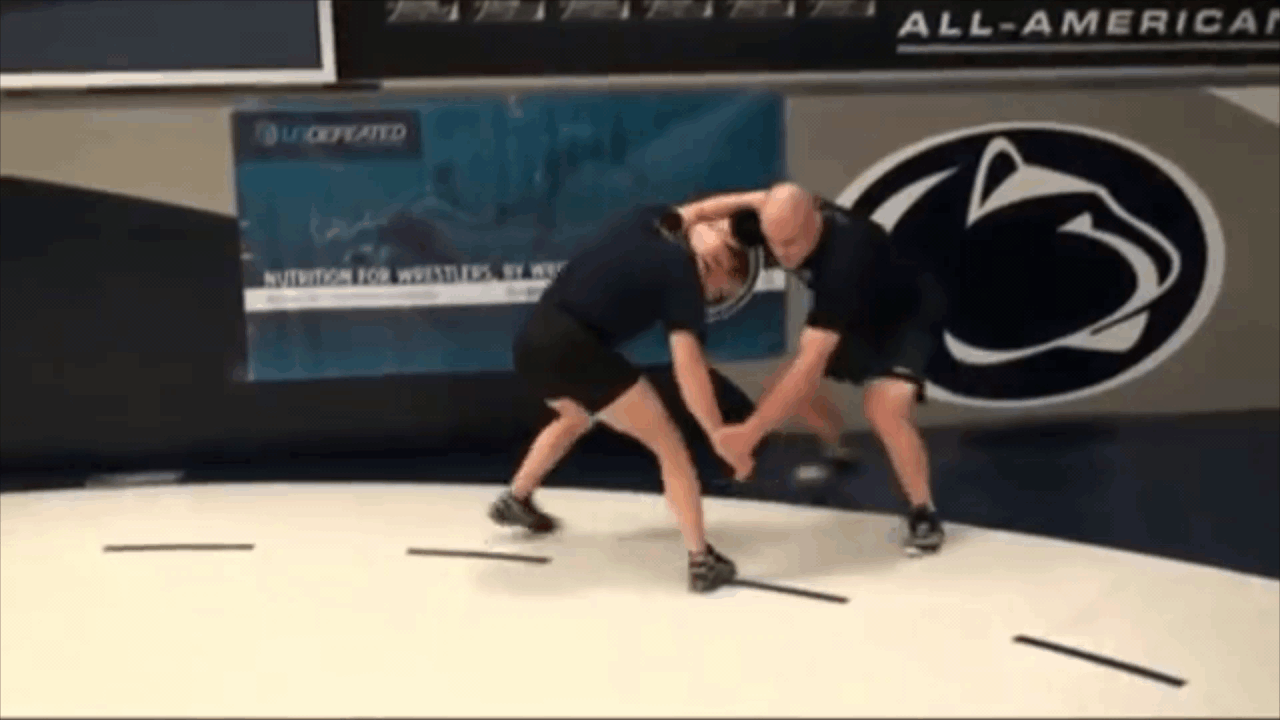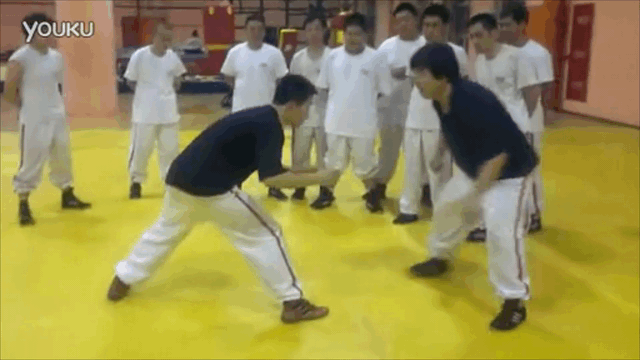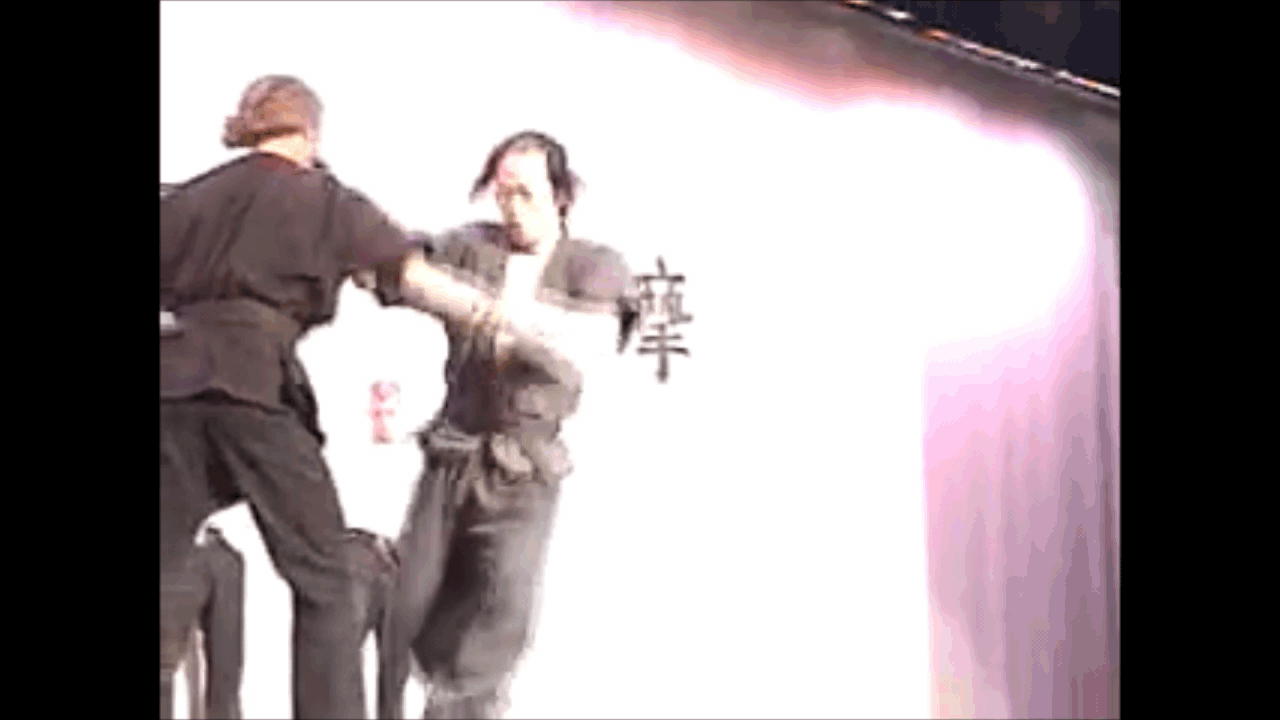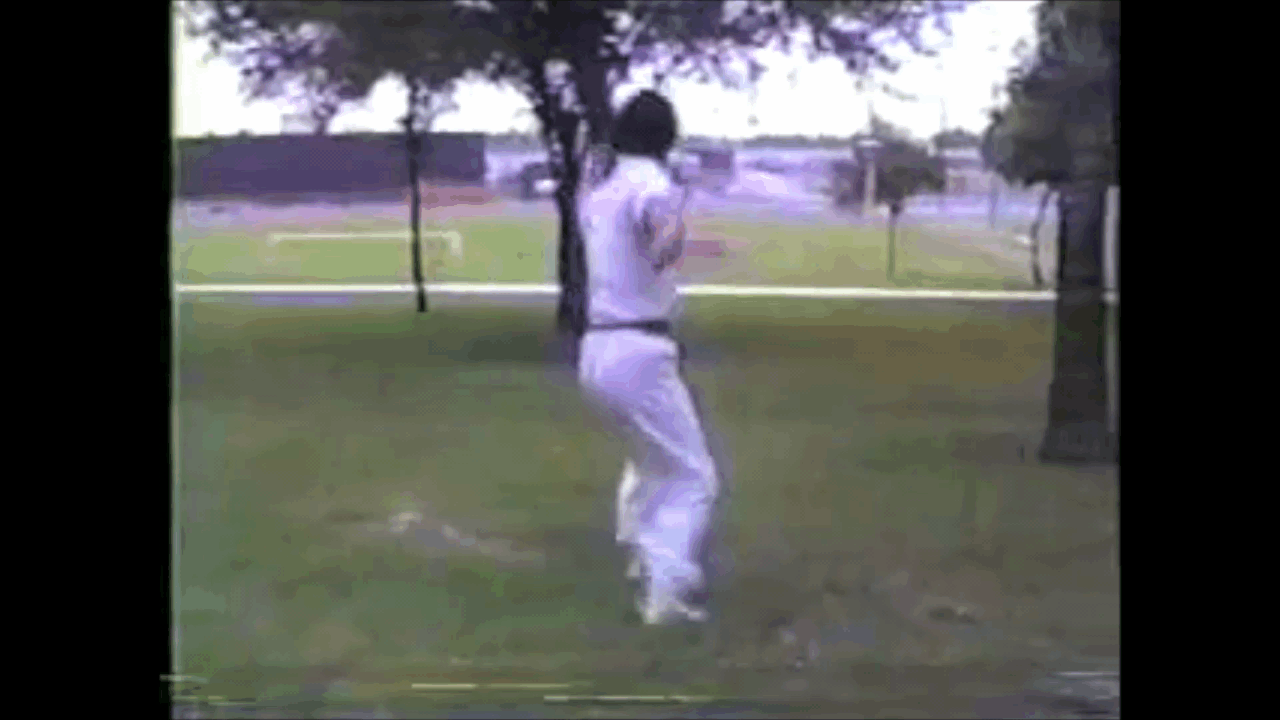It's a trade-off. The ankle pick requires you to get lower and has some of the disadvantages you mention. On the other hand, it can give significantly more leverage for pulling someone's leg out from under them.I don't understand why people like to use "ankle pick" instead of "knee seize"?
- You have to reach much lower to your opponent's ankle than just to reach behind his knee.
- If you drop your knee down on the ground, you lose your mobility.

His left hand only have to move 1/2 of the distance o reach behind his opponent's knee. If he drops his right knee into his opponent's groin with his body weight behind it, it can be a good finish move.

By using knee seize, you can take your opponent down and then take off. You can't do that by using ankle pick with knee dropping.

Navigation
Install the app
How to install the app on iOS
Follow along with the video below to see how to install our site as a web app on your home screen.
Note: This feature may not be available in some browsers.
More options
Style variation
You are using an out of date browser. It may not display this or other websites correctly.
You should upgrade or use an alternative browser.
You should upgrade or use an alternative browser.
It really is the system.
- Thread starter drop bear
- Start date
You can let your leg to do 1/2 of the ankle pick for you.It's a trade-off. The ankle pick requires you to get lower and has some of the disadvantages you mention. On the other hand, it can give significantly more leverage for pulling someone's leg out from under them.

If punching is allowed, when you try to pick up your opponent's ankle, you want your head to be far away from his punch, but your hand still have to be able to reach to his ankle. This will put you in a very difficult body posture.It's a trade-off. The ankle pick requires you to get lower and has some of the disadvantages you mention. On the other hand, it can give significantly more leverage for pulling someone's leg out from under them.

In the following clip, it's clear that his opponent's left hook can land on his head. If punching is allowed, what's the successful rate for the "ankle pick"?

Last edited:
Also to train in a "pure striking art" (no respect to single leg), or a "pure grappling art" (no respect to head punch) will hold back the kick/punch/lock/throw/ground_game integration.a bad system will hold back the development of the individual.
I don't think the following fighting stance will fit in the MMA environment. The more you train like this, the more bad habit that you will bring into your MMA.

Last edited:
In the following clip, it's clear that his opponent's left hook can land on his head. If punching is allowed, what's the successful rate for the "ankle pick"?

They are already clinched - picker's right hand is behind op's head and would be well positioned to cover.
That said, for the obvious reasons you mention you don't see too many ankle picks in mma.
What I'm trying to say is before the clinch, there was no fist flying.They are already clinched - picker's right hand is behind op's head and would be well positioned to cover.
That said, for the obvious reasons you mention you don't see too many ankle picks in mma.
This is why I believe if you train MMA as your goal, you have to modify a lot of your technique training.
Is that a good idea, or a bad idea?
Last edited:
My view is that things like this can happen in real fights. Whether it’s a mistake made or simply a better entry than the student could defend. I don’t stop it unless it’s a safety issue (or moves beyond the point of a specific drill, but that’s a different context). Problem solving skills are an important factor, and they only develop through problems.Similar in grappling (for me). If you are my student and your partner shoots and puts you in this position, then I'm not interested in seeing anymore. This is such an epic failure that, the first lessons is prevent this. I wouldn't care if the other student doesn't get experience in fighting on the ground. I would stop the fight and then lecture the student. Nothing good can come from this. Then I would ask the other student to do it again
drop bear
Sr. Grandmaster
If punching is allowed, when you try to pick up your opponent's ankle, you want your head to be far away from his punch, but your hand still have to be able to reach to his ankle. This will put you in a very difficult body posture.

In the following clip, it's clear that his opponent's left hook can land on his head. If punching is allowed, what's the successful rate for the "ankle pick"?

It is very risky to punch from there as you give up the real estate around the legs and hips.
drop bear
Sr. Grandmaster
What I'm trying to say is before the clinch, there was no fist flying.
This is why I believe if you train MMA as your goal, you have to modify a lot of your technique training.
Is that a good idea, or a bad idea?
You can use striking to enter the clinch. Either his or yours.
You could wait for his left hook, cover and take the clinch before he gets his arm back.
drop bear
Sr. Grandmaster
I don't understand why people like to use "ankle pick" instead of "knee seize"?
- You have to reach much lower to your opponent's ankle than just to reach behind his knee.
- If you drop your knee down on the ground, you lose your mobility.

His left hand only have to move 1/2 of the distance o reach behind his opponent's knee. If he drops his right knee into his opponent's groin with his body weight behind it, it can be a good finish move.

By using knee seize, you can take your opponent down and then take off. You can't do that by using ankle pick with knee dropping.

We do a knee tap as part of a combination.
So say go for a single leg, lose it. It goes to the ground. Hit the knee tap.
To me it's a safety issue. I had a student who would never keep their guard up. I stopped that student from sparring until they learn how to keep their guard up. It doesn't matter if it's light sparring or hard sparring. Bad fundamentals have to be correct on the spot because they are so costly in a real fight.My view is that things like this can happen in real fights. Whether it’s a mistake made or simply a better entry than the student could defend. I don’t stop it unless it’s a safety issue
If a students gets caught in this position then he has failed to solve the first problem which is "How to never be in this position." This position is so compromised that one can accurately guess that every solution that follows will be equally as bad or worse. This is so fundamental that wrestlers and grapplers drill this to the point that it will "never happen to them" with a possibility near zero. For me personally, I wouldn't train on top of bad fundamentals. Training to get out of bad situations is one thing. Having broken fundamentals isn't a bad situation; it's a "No Go"
I understand what you are saying but the clip is not a good reference. When I was training the application of the lows horse stance I came to the same conclusion you are mentioning now. I showed my BJJ partner and asked him how would he enter. He said that he wouldn't because of the possibility of the strikes to the head. What you are mentioning only works if the person defending is in a low stance. It doesn't work if a person is in a high stance because the punching mechanics will be significantly weaker.In the following clip, it's clear that his opponent's left hook can land on his head. If punching is allowed, what's the successful rate for the "ankle pick"?
There are also other positioning things that occur that aren't showing in this video. A hook in this position will mean that defender will also need to do some evasive foot work that will allow him to land the hook. this gif doesn't show that path or possibility

dvcochran
Grandmaster
Well said.My view is that things like this can happen in real fights. Whether it’s a mistake made or simply a better entry than the student could defend. I don’t stop it unless it’s a safety issue (or moves beyond the point of a specific drill, but that’s a different context). Problem solving skills are an important factor, and they only develop through problems.
Yokozuna514
2nd Black Belt
I think I can see why you are saying a stoppage for safety here can become a teachable moment, however if that student "never" keeps their guard up can it be that he hasn't seen the consequence of his actions to learn from his mistake ? I am not advocating that they have their head taken off but I am saying that if you allow the contest to play out longer, the student should eventually 'learn' the consequence for not keeping his guard up. A practical tap given consistently should teach him the error of his ways. If he can't learn through practice how will he be able to understand the verbal instruction ? IE: sometimes a picture can say a thousand words, imho.To me it's a safety issue. I had a student who would never keep their guard up. I stopped that student from sparring until they learn how to keep their guard up. It doesn't matter if it's light sparring or hard sparring. Bad fundamentals have to be correct on the spot because they are so costly in a real fight.
If a students gets caught in this position then he has failed to solve the first problem which is "How to never be in this position." This position is so compromised that one can accurately guess that every solution that follows will be equally as bad or worse. This is so fundamental that wrestlers and grapplers drill this to the point that it will "never happen to them" with a possibility near zero. For me personally, I wouldn't train on top of bad fundamentals. Training to get out of bad situations is one thing. Having broken fundamentals isn't a bad situation; it's a "No Go"

Just for clarification but are you suggesting hooks from a low horse stance ?I understand what you are saying but the clip is not a good reference. When I was training the application of the lows horse stance I came to the same conclusion you are mentioning now. I showed my BJJ partner and asked him how would he enter. He said that he wouldn't because of the possibility of the strikes to the head. What you are mentioning only works if the person defending is in a low stance. It doesn't work if a person is in a high stance because the punching mechanics will be significantly weaker.
There are also other positioning things that occur that aren't showing in this video. A hook in this position will mean that defender will also need to do some evasive foot work that will allow him to land the hook. this gif doesn't show that path or possibility

At the time the student didn't learn. I even warned "that if you can't protect yourself then I will restrict you from sparring." Sometimes learning consequence the hard way will create a phobia. It doesn't correct the issue at hand, but will have the effect of making the person not want to participate in sparring at all. Where you would learn to keep your hands up. There answer would be "don't do sparring." When that happens now I have 2 problems, as a teacher. The original problem and then the new problem of trying to have them over come the fear of sparring , because someone clocked them big time. This is kind of what happened to the student that I'm speaking of. But I was able to manage that fear by sparring with the student and only using taps on the head as a reminder vs punches.I think I can see why you are saying a stoppage for safety here can become a teachable moment, however if that student "never" keeps their guard up can it be that he hasn't seen the consequence of his actions to learn from his mistake ? I am not advocating that they have their head taken off but I am saying that if you allow the contest to play out longer, the student should eventually 'learn' the consequence for not keeping his guard up.
There were a lot of taps lol. It put me in a situation to try and understanding what was going on through the student's perspective. After many rounds, many taps, and many questions later. I learned that she was too focused on trying to hit a specific spot. In the school there were 2 approaches taught.A practical tap given consistently should teach him the error of his ways. If he can't learn through practice how will he be able to understand the verbal instruction ?
1. You pick a spot that you want to hit then go for it (this was the other instructor's approach)
2. You attack what your opponent gives you ( this was my approach.)
The student picked #1 to use and it was causing a sever case of tunnel vision and unawareness. I would rank it on the scale of walking with while chatting on a phone, where you can see things in the area of your hand and phone, but are clueless to other things going on.
#2 would be like going to a store and trying to fart in an area where people wouldn't know that you were the one who did it. So you are more aware of your environment and the timing in which you let it go. You also tend to take the opportunity vs having a predetermined place where you'll let your fart out. If you can get to the bathroom then great. But most people scan the environment and take the opportunity.
When sparring the student wasn't "scanning the environment" an as a result had really bad tunnel vision. I literally could leave an opening and just wait to see how long it would take for the student to go for it. When asked "Why didn't you go for the spot I left open?" the answer was "I didn't see it."
But like you stated. The taps are better than the punches in this case. If a person has tunnel vision like that then getting hit in the head isn't associated with "Keep your hands up." To this day I don't think the students spars. The other instructor would hit the student in the head and it basically demoralized the student.
Yes you can throw hooks from a low horse stance, but it's done in the context of someone going for a single leg take down. It's possible to throw hooks, palm strikes, tiger's claw, slaps, jabs, and uppercuts with no problem. I know it sounds crazy, but you have to keep it in context. Like it's possible to throw jabs, hooks, and elbows while on your knees. Just saying it like that sounds stupid, but in the context of being in mount, it makes sense.Just for clarification but are you suggesting hooks from a low horse stance ?
edit: The only thing that some people will have trouble with is driving power. If you are used to driving power by pivoting on your foot, then this will be difficult. If you are the type that drives power by pushing the rear leg then you shouldn't have too much trouble with making the shots count. In low stances the punches are done with flat feet, because you are in a stance height for use against grappling.
Last edited:
I love seeing things like this. There are some techniques I learned in NGA that don't make much application sense to me in their "classical" form (the formal teaching version). But this really looks like it might be the same principle as one of them...need to remember this the next time I have a training partner to play with.We do a knee tap as part of a combination.
So say go for a single leg, lose it. It goes to the ground. Hit the knee tap.
I guess I look at it from the other side. I want them to solve the problem all the way through, then we can go back and work on what they could have done to stay out of it. My approach comes from seeing people develop a habit of stopping when they make a mistake, rather than finding a way out of the mess. A bad habit to have in a fight, whether that's competitive or a self-defense situation. There are likely other ways to keep that habit from developing.To me it's a safety issue. I had a student who would never keep their guard up. I stopped that student from sparring until they learn how to keep their guard up. It doesn't matter if it's light sparring or hard sparring. Bad fundamentals have to be correct on the spot because they are so costly in a real fight.
If a students gets caught in this position then he has failed to solve the first problem which is "How to never be in this position." This position is so compromised that one can accurately guess that every solution that follows will be equally as bad or worse. This is so fundamental that wrestlers and grapplers drill this to the point that it will "never happen to them" with a possibility near zero. For me personally, I wouldn't train on top of bad fundamentals. Training to get out of bad situations is one thing. Having broken fundamentals isn't a bad situation; it's a "No Go"

Yokozuna514
2nd Black Belt
Hey, it's easy for me as an outsider and not being there to make suggestions to do this or do that or take this approach. There is usually more to it than that when you spend the time to get to know what is really the issue with that particular student. One approach to fixing a problem does not always render the same result. Corrections in class (or any attention) can get some people to just shut down to the point they no longer pay attention. These folks may do better in a smaller group setting where things can be less formal and they are more open to 'listening' and 'understanding' instructions. Just a different way of learning but that has been my experience. Not everyone learns the same way and as a man I have to be cognizant that my voice and tone can be received totally differently from the way I believe I am sending the message.At the time the student didn't learn. I even warned "that if you can't protect yourself then I will restrict you from sparring." Sometimes learning consequence the hard way will create a phobia. It doesn't correct the issue at hand, but will have the effect of making the person not want to participate in sparring at all. Where you would learn to keep your hands up. There answer would be "don't do sparring." When that happens now I have 2 problems, as a teacher. The original problem and then the new problem of trying to have them over come the fear of sparring , because someone clocked them big time. This is kind of what happened to the student that I'm speaking of. But I was able to manage that fear by sparring with the student and only using taps on the head as a reminder vs punches.
There were a lot of taps lol. It put me in a situation to try and understanding what was going on through the student's perspective. After many rounds, many taps, and many questions later. I learned that she was too focused on trying to hit a specific spot. In the school there were 2 approaches taught.
1. You pick a spot that you want to hit then go for it (this was the other instructor's approach)
2. You attack what your opponent gives you ( this was my approach.)
The student picked #1 to use and it was causing a sever case of tunnel vision and unawareness. I would rank it on the scale of walking with while chatting on a phone, where you can see things in the area of your hand and phone, but are clueless to other things going on.
#2 would be like going to a store and trying to fart in an area where people wouldn't know that you were the one who did it. So you are more aware of your environment and the timing in which you let it go. You also tend to take the opportunity vs having a predetermined place where you'll let your fart out. If you can get to the bathroom then great. But most people scan the environment and take the opportunity.
When sparring the student wasn't "scanning the environment" an as a result had really bad tunnel vision. I literally could leave an opening and just wait to see how long it would take for the student to go for it. When asked "Why didn't you go for the spot I left open?" the answer was "I didn't see it."
But like you stated. The taps are better than the punches in this case. If a person has tunnel vision like that then getting hit in the head isn't associated with "Keep your hands up." To this day I don't think the students spars. The other instructor would hit the student in the head and it basically demoralized the student.
I've dealt with men, women and children who are handi-able as well as handi-capped (physically, mentally and sometimes both). It is not always easy to get to their level and make them understand that you are there to help improve their experience but they also must be willing to put in the effort to be open and try. Persistence and ingenuity pay off so good luck and keep trying. When they get their 'aha' moment you will be amazed at what kind of doors that opens for them.
Agree at least that clip starts with a clinch (even if it doesn't start with fist flying).They are already clinched ...
The following clip doesn't start with a clinch. IMO, it's a mistake to attack with single leg while your opponent's arms are free.
Similar threads
- Replies
- 110
- Views
- 13K
- Replies
- 607
- Views
- 68K
- Replies
- 44
- Views
- 8K
- Replies
- 122
- Views
- 11K
